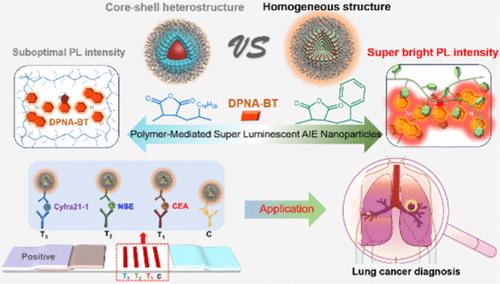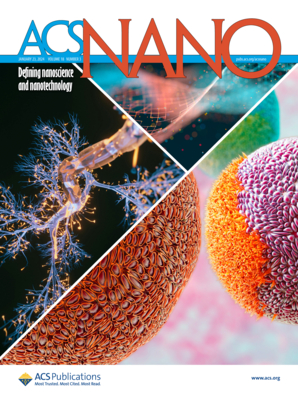Fully Inter-restricted Assembly of Aggregation-Induced Emission Luminogens and Polymers Enables Ultra-bright Nanoparticles for Sensitive Point-of-Care Diagnosis
IF 15.8
1区 材料科学
Q1 CHEMISTRY, MULTIDISCIPLINARY
引用次数: 0
Abstract
Fluorescent lateral flow immunoassay (LFIA) is recognized as a leading quantitative point-of-care (POC) platform for precise clinical diagnostics. However, conventional fluorescent nanoprobes are hampered by low quantum yield (QY), which constrain the sensitivity of fluorescent LFIA. Herein, we employed a butterfly aggregation-induced emission luminogen (AIEgen) and developed the fully inter-restricted assembly with a polyphenyl polymer poly(maleicanhydride-styrene) (PMPS) to create highly fluorescent homogeneous nanoparticles (ho-AIENPs) with QY over 91%. Compared to conventional fluorescent nanoparticles with a core–shell heterostructure (he-AIENPs), ho-AIENPs demonstrate a homogeneous structure with AIEgens uniformly dispersed in the PMPS matrix nanoparticles. The robust and broad intermolecular interaction (e.g., π–π interactions) between PMPS and AIEgens effectively restricts the molecular motion of AIEgens, producing a 30% increase in the QY of ho-AIENPs than he-AIENPs. Ho-AIENPs exhibit a 5-fold and 80-fold improved sensitivity compared to traditional he-AIENP-based fluorescent LFIAs and AuNP-based colorimetric LFIAs. Owing to the excellent optical properties of ho-AIENPs, we developed ho-AIENP-based multiplex LFIAs, which can simultaneously detect lung cancer biomarkers with exceptionally high sensitivity. In contrast to the conventional core–shell assembly and physical encapsulation strategies, the fully inter-restricted assembly strategy is promising, versatile, and efficient in enhancing the polymer matrix-derived fluorescent particles and sensitizing the immunoassays.

求助全文
约1分钟内获得全文
求助全文
来源期刊

ACS Nano
工程技术-材料科学:综合
CiteScore
26.00
自引率
4.10%
发文量
1627
审稿时长
1.7 months
期刊介绍:
ACS Nano, published monthly, serves as an international forum for comprehensive articles on nanoscience and nanotechnology research at the intersections of chemistry, biology, materials science, physics, and engineering. The journal fosters communication among scientists in these communities, facilitating collaboration, new research opportunities, and advancements through discoveries. ACS Nano covers synthesis, assembly, characterization, theory, and simulation of nanostructures, nanobiotechnology, nanofabrication, methods and tools for nanoscience and nanotechnology, and self- and directed-assembly. Alongside original research articles, it offers thorough reviews, perspectives on cutting-edge research, and discussions envisioning the future of nanoscience and nanotechnology.
 求助内容:
求助内容: 应助结果提醒方式:
应助结果提醒方式:


